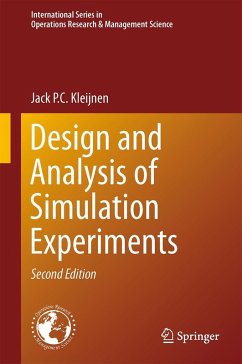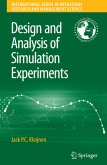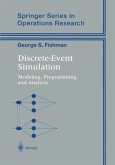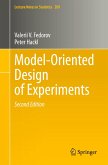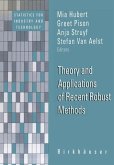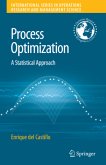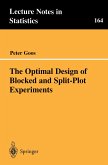This is a new edition of Kleijnen's advanced expository book on statistical methods for the Design and Analysis of Simulation Experiments (DASE). Altogether, this new edition has approximately 50% new material not in the original book. More specifically, the author has made significant changes to the book's organization, including placing the chapter on Screening Designs immediately after the chapters on Classic Designs, and reversing the order of the chapters on Simulation Optimization and Kriging Metamodels. The latter two chapters reflect how active the research has been in these areas.
The validation section has been moved into the chapter on Classic Assumptions versus Simulation Practice, and the chapter on Screening now has a section on selecting the number of replications in sequential bifurcation through Wald's sequential probability ration test, as well as a section on sequential bifurcation for multiple types of simulation responses. Whereas all references in the original edition were placed at the end of the book, in this edition references are placed at the end of each chapter.
From Reviews of the First Edition:
"Jack Kleijnen has once again produced a cutting-edge approach to the design and analysis of simulation experiments." (William E. BILES, JASA, June 2009, Vol. 104, No. 486)
The validation section has been moved into the chapter on Classic Assumptions versus Simulation Practice, and the chapter on Screening now has a section on selecting the number of replications in sequential bifurcation through Wald's sequential probability ration test, as well as a section on sequential bifurcation for multiple types of simulation responses. Whereas all references in the original edition were placed at the end of the book, in this edition references are placed at the end of each chapter.
From Reviews of the First Edition:
"Jack Kleijnen has once again produced a cutting-edge approach to the design and analysis of simulation experiments." (William E. BILES, JASA, June 2009, Vol. 104, No. 486)
Review of the 1st Edition:
"This work represents a lucid, comprehensive, authoritative, and highly informative presentation of the techniques and methodology associated with simulation experimentation. The book is 'lucid' because, as the word implies, it sheds light on the subject matter of simulation experimentation and optimization; it is 'comprehensive' because it addresses all of the essential topics in the field; it is 'authoritative'' because it captures the essence of the best research in the field, as evidenced by its more than 400 authoritative citations; and it is ''informative' in that it distills the most important scholarship of the last six decades into a 210-page study of the DASE field. Jack Kleijnen has once again produced a cutting-edge approach to the design and analysis of simulation experiments. His 1974-75 books were an incisive compilation of statistical methodology in simulation and introduced the term metamodeling to the lexicon of simulation experimentation. His 2008 volume Design and Analysis of Simulation Experiments promises to popularize the term DASE in the same way. Many of us who specialize in the field of simulation experimentation and optimization have avidly followed Kleijnen's writings for almost four decades. This latest work leads the way in this endeavor, and is a vital addition to the important scholarship in the field." (William E. BILES, JASA, June 2009, Vol. 104, No. 486)
"This work represents a lucid, comprehensive, authoritative, and highly informative presentation of the techniques and methodology associated with simulation experimentation. The book is 'lucid' because, as the word implies, it sheds light on the subject matter of simulation experimentation and optimization; it is 'comprehensive' because it addresses all of the essential topics in the field; it is 'authoritative'' because it captures the essence of the best research in the field, as evidenced by its more than 400 authoritative citations; and it is ''informative' in that it distills the most important scholarship of the last six decades into a 210-page study of the DASE field. Jack Kleijnen has once again produced a cutting-edge approach to the design and analysis of simulation experiments. His 1974-75 books were an incisive compilation of statistical methodology in simulation and introduced the term metamodeling to the lexicon of simulation experimentation. His 2008 volume Design and Analysis of Simulation Experiments promises to popularize the term DASE in the same way. Many of us who specialize in the field of simulation experimentation and optimization have avidly followed Kleijnen's writings for almost four decades. This latest work leads the way in this endeavor, and is a vital addition to the important scholarship in the field." (William E. BILES, JASA, June 2009, Vol. 104, No. 486)
"This work represents a lucid, comprehensive, authoritative, and highly informative presentation of the techniques and methodology associated with simulation experimentation. The book is 'lucid' because, as the word implies, it sheds light on the subject matter of simulation experimentation and optimization; it is 'comprehensive' because it addresses all of the essential topics in the field; it is 'authoritative'' because it captures the essence of the best research in the field, as evidenced by its more than 400 authoritative citations; and it is ''informative' in that it distills the most important scholarship of the last six decades into a 210-page study of the DASE field. Jack Kleijnen has once again produced a cutting-edge approach to the design and analysis of simulation experiments. His 1974-75 books were an incisive compilation of statistical methodology in simulation and introduced the term metamodeling to the lexicon of simulation experimentation. His 2008 volume Design and Analysis of Simulation Experiments promises to popularize the term DASE in the same way. Many of us who specialize in the field of simulation experimentation and optimization have avidly followed Kleijnen's writings for almost four decades. This latest work leads the way in this endeavor, and is a vital addition to the important scholarship in the field." (William E. BILES, JASA, June 2009, Vol. 104, No. 486)

